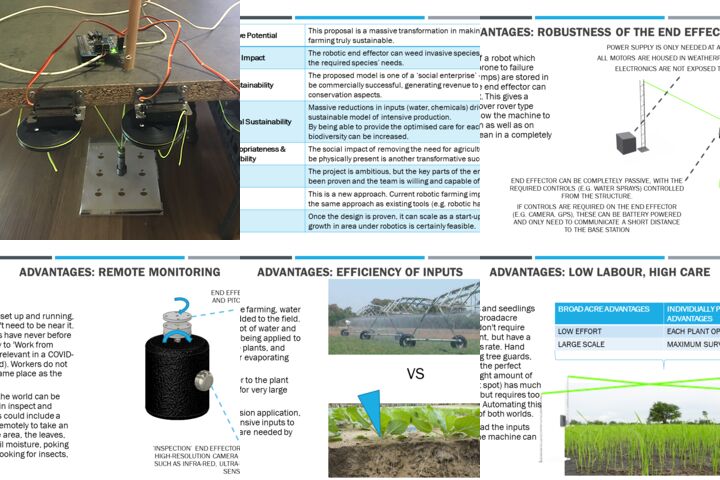Game-changing robots
The Problem
The current model of farming is unsustainable in many areas and applications. Previously, farming was done in a labour intensive manner, with minimal chemical input (e.g. weeding by hand rather than spraying pesticide). With high wages in developed countries and demand for high productivity, there is an accepted thinking that the current model of using expensive and harmful pesticides and fertilisers is the most effective way to farm. With increasing demand for agricultural products, there is more pressure than ever on farmland. As of March 2020, COVID-19 represents an enormous challenge to food production. With agricultural workers in quarantine, there is limited ability to meet production. Coastal water presents another area ripe for aquaculture production, but is difficult to farm and presently only used for niche applications. This inability to effective farm in the ocean, despite it's enormous potential is a problem to be overcome.
Our Proposal
Our proposal is a new sort of robotic farming, suitable for medium-sized areas. By using a cable robot system, a large area can be covered. By keeping the drive system out of the farming area, the system can be kept robust and functional in environments that other farming robots are unable to perform in. Multiple posts (3-9) will be erected over the work area (areas of 2 to 16 hectares will be suitable, with posts installed approximately 400m apart). Next to one of these posts, a structure will house all the electrical and mechanical components . For each post, there will be a motor and winch, driving a cable back and forth, routed through a pulley on the post and to an end effector. The end effector will travel over the work area, driven by these cables. The end effector will be outfitted with the required implements for farming. Initially, a camera will be used for monitoring the farming work area. Subsequent 'tools' are likely to include a water distribution spray, moisture probes, weeding grippers, planting equipment, and chemical (fertiliser, pesticide, nutrient, etc) distributors. The end effector will be outfitted with necessary sensors to provide feedback for the robot to effectively navigate it's required tasks (e.g. cameras, GPS).
We Assume that...
A financial case can be made to make the project profitable. In order to have the transformative potential that is necessary to drive the change, it needs to be profitable.
Constraints to Overcome
Agricultural and Aquacultural farming environments are notoriously tough on equipment. Dust, salt, UV, corrosion, animal interference, poor quality infrastructure are all issues for farming robots to overcome. Cable robots are a game-changer in this space, as they can be built as robustly as needed and do not need to travel on the ground or water. This does seem like an enourmously ambitious project. However, a boot-strapped intial project to get a few hectares of high-value crops (e.g. vineyards) under a basic prototype doing camera survellience of weeds should immediately provide value for the farmer and revenue for the project. This can then be ramped up into new end effectors for irrigation, spraying, and from there on more ambitious end effectors can be implemented.
Current Work
A desktop prototype has been built. A scale model has been developed and fully detailed in CAD and will be built in the next month. Financial projections have been developed, showing that there are application cases where the project will be profitable. Application areas have been selected where the project can have the greatest environmental impact.
Current Needs
A full-size prototype needs to be built as a case study in a successful implementation. This will be built and installed for on-farm site trials in collaboration with a supportive land-holder. A demonstration prototype as a proof-of-concept for cable robot farming in the ocean will be developed. Supporters in government and private industry will be engaged for feedback, trials and funding on a commercial basis.
